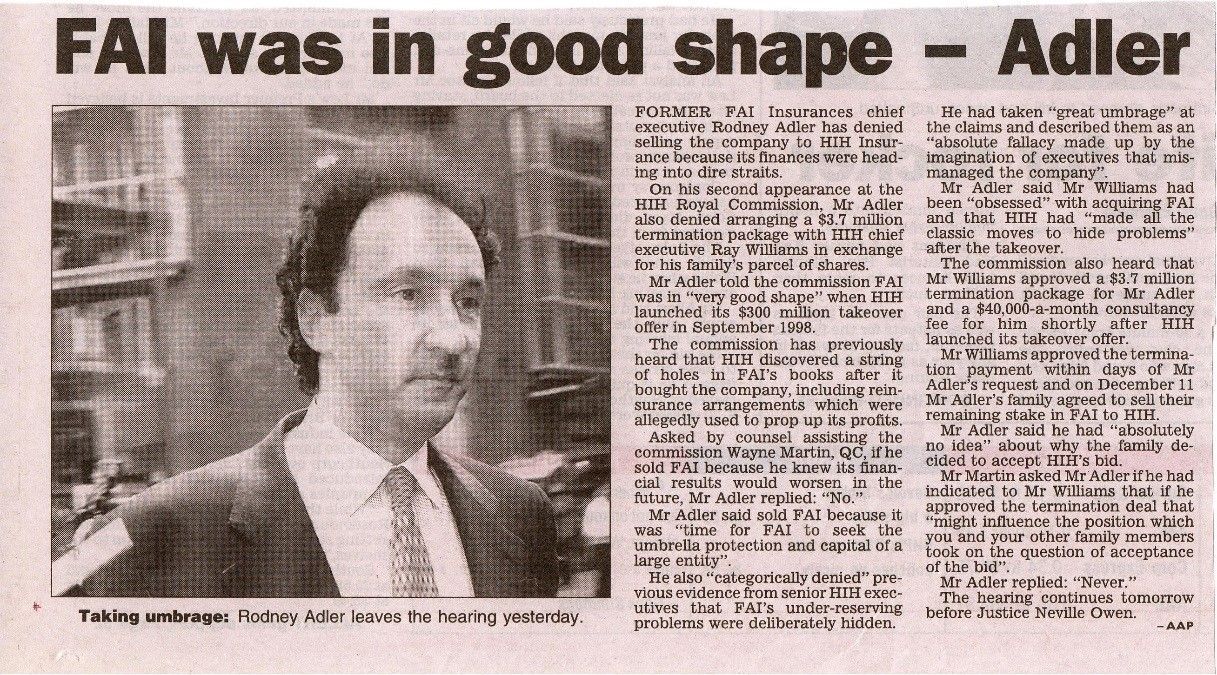What is Creative Accounting, Sloppy Accounting and Fraudulent Accounting?
A discussion on terms such as creative accounting, sloppy accounting and fraudulent accounting is usually in connection with the presentation of ‘financial report’ for a company (or group of entities) operating a business, so before launching into creative accounting, sloppy accounting and fraudulent accounting, I would like to first address what is a financial report and types of financial reports.
What is a financial report?
Section 295 of the Corporations Act 2001 (Cth) sets out the contents of a financial report, which comprise the following three important documents:
- Financial statements. The financial statements can be broken down into the following three reports:
- statement of financial position, commonly known as a ‘balance sheet’ setting out the assets and liabilities of the company,
- statement of financial performance, commonly known as a profit and loss statement; and
- statement of cash flows. For private companies which are classified as ‘small proprietary limited’ companies using the criteria set out under 45A(2) of the Corporations Act 2001 (Cth), it is not unusual for the financial statements to exclude a statement of cash flows.
- Notes to the financial statements. The notes to the financial statements sets out the following:
- the accounting policies adopted in the preparation of the financial statements; and
- more detail in relation to the aggregated numbers included in the financial statements.
- Directors’ declaration. This report is typically only 1 page long, but it includes two important statements:
- a statement about the company’s ability to pay its debts as and when they fall due, which is essentially a declaration of the company’s solvency.
- that the company complies with all the accounting policies as described in the notes to the financial statements and that the financial statements and notes to the financial statements present a ‘true & fair’ view.
Types of financial reports
Financial reports are typically published by a company and provided to third parties for a particular period, usually a financial year which for most companies runs from 1 July to 30 June. There are two types of financial reports:
- General purpose financial reports. General purpose financial reports are to comply with all the Australian accounting standards which are relevant to the company; and
- Special purpose financial reports. Special purpose financial reports may comply with only some Australian accounting standards or it may refer to none of the Australian accounting standards.
The financial reports ought to disclose within the ‘notes to the financial statements’ and in the ‘directors’ declaration’ whether the financial report is considered a ‘general purpose’ or ‘special purpose’ financial report. Generally speaking[1],
- public companies publish general purpose financial reports; and
- private companies publish special purpose financial reports.
Some of the public may view an accountant as a person who captures transactions to simply record financial history by following black & white rules. The reality is that accounting is somewhat abstract and there is always more than one way to report history in the financial reports, even when adopting Australian accounting standards because application of Australian accounting standards requires professional judgement.
Irrespective of whether a financial report is considered ‘general purpose’ or ‘special purpose’, the objective of the financial report is to present a ‘true and fair’ view of the financial position and financial performance of the company. There is no prescriptive accounting definition on what ‘true and fair’ means – what is ‘true and fair’ is ultimately a matter for the courts to determine, usually with the assistance of expert evidence, often given by a forensic accountant.
Australian accounting standards provide that if there are ‘material’ misstatements included in the financial reports then the financial reports are likely to be misleading to users relying on the financial reports. Therefore misleading financial reports cannot present a ‘true and fair’ view of company’s financial position and financial performance. Australian accounting standards provide guidance on what is considered ‘material’ for the purposes of avoiding the preparation of misleading financial reports, which is a matter of professional judgment, based on qualitative and quantitative factors.
Now we have talked about financial reports, the presentation on what is included therein will be influenced by, what I characterise as Creative Accounting, Sloppy Accounting and Fraudulent Accounting.
What is Creative Accounting?
Creating Accounting is a bit of loaded term because there is a misconception that it suggests something illegal, fraudulent or misrepresented. This misconception could arise from instances where creative accounting has been noted by financial commentators in connection with a company when fraud is discovered or the company later collapses and enters into liquidation.
Creative accounting is simply an acknowledgement that there may be a range of possible answers i.e. descriptions and numbers included in a financial report) when adopting generally accepted accounting principles (and Australian Accounting Standards provide authoritative guidance when describing generally accepted accounting principles).
It is important to stress that:
- creative accounting is not illegal;
- the application of creative accounting can be intentional by management of the company;
- creative accounting is legitimate provided the financial reports give a ‘true and fair’ view of the company’s financial position and financial performance; and
- financial reports which have been audited by an independent auditor are not immune to creative accounting.
Creative accounting techniques
The following are just a few of the many sorts of ways creative accounting can be used with respect to general purpose financial reports (which are audited by an independent auditor):
- The company’s decision to enter into related party transactions which are not on a commercial basis;
- Application of lease accounting and use of off-balance sheet finance;
- Recognition of revenue which might involve the recognition of revenue under an arrangement up-front rather than spread out over a period of time;
- Decisions over the useful lives of plant and equipment effecting depreciation;
- Provisions and warranties requiring estimations as to future outgoings for items such warranties, obsolescence and bad debts; and
- Consolidation of separate legal business entities into a single group which could mask poor performance in a particular entity.
The scope for creative accounting is significantly greater when it comes to a company which produces special purpose financial reports, particularly if they have not been subject to audit, because the company is not obliged to comply with Australian accounting standards.
What is sloppy accounting?
Slopping accounting only applies to special purpose financial reports which have not been audited and is probably best described in relation to a company’s financial reports where the accounting policies adopted have not been complied with and/or the accounting policies adopted are not appropriate.
Examples of sloppy accounting include the absence of all appropriate year-end accrual adjustments such as:
- Inventory reflecting closing stock values have not been recorded.
- Assets subject to depreciation have been booked as expenses in the year of purchase.
- Current year’s depreciation not recorded.
- Unearned income not recognised as a liability.
- Company related expenses not paid by the directors, not booked as company expenses.
Unsigned directors’ declarations within a financial report with no accompanying income tax return (or income tax return with no evidence of lodgement of the tax return with the Australian Taxation Office) may reflect a draft version of the financial report which could be subject to sloppy accounting.
Sloppy accounting (by my definition) cannot result in the financial reports being a true and fair representation of the company’s financial position and financial performance.
What is fraudulent accounting?
Fraudulent accounting is a deliberate deception involving the presentation of financial reports that cannot be a true and fair representation of financial performance.
While creative accounting (sometimes referred to as ‘window addressing’) are permissible under the law, fraudulent accounting is illegal because the company is claiming the presented financial reports provide a true and fair view of the company’s financial position and financial performance with the knowledge that they are not a true and fair view. This knowledge held by the company is for the purpose of deceiving the users or readers (i.e. third parties to the company) as to the true and fair view of the company’s financial position and financial performance.
There are many examples of publicly listed companies (e.g. Enron, being a well-documented example) presenting financial reports which have been independently audited and have been subsequently found to have prepared fraudulent financial reports. While independent auditors have to consider the possibility of fraudulently prepared financial statements, an independent auditor’s primary role is not to look for fraud and the scope and nature of an audit does not involve reviewing each and every transaction which comprise the financial statements.
How a forensic accountant considers creative accounting
A forensic accountant must understand human behaviour and step into the shoes of management and understand the motives of management when preparing financial reports for a company. Management may be highly motivated to want to leave a favourable or unfavourable impression depending on whether it seeks to want to impress or depress a particular reader of the financial reports.
For example:
- Management and business owners who wish to impress existing shareholders, banks, and potential investors may adopt a more aggressive attitude regarding how the net assets and net profits are reported in the financial Reports. Usually, the motivation for adopting an aggressive attitude is an expectation of some kind of carrot, like a bonus or additional finance.
- Management and business owners who are involved in a dispute (e.g. spouse seeking divorce), want to pay less tax, are interested in buying-out other partners or have a pessimistic outlook may adopt a more conservative attitude to depress the values of net assets and net profits. Usually, the motivation for adopting a conservative attitude is to avoid being at the end of a large stick, like a tax bill, large settlement to a spouse or an outgoing business partner.
Being too conservative or aggressive can cross the line into fraud if it can be proved that there is a deliberate intention to harm or gain a benefit. However, proving fraud can be quite challenging, particularly where there are numerous conflicting motivating forces at work.
Summary and conclusion
Confusion can arise when creative accounting is pushed to the extremes producing significant financial consequences. In these situations, the lines between creative, accounting and fraudulent accounting can be quite murky. As a forensic accountant working in disputes, one party in the dispute may argue window dressing and the other party argues it is fraud. Unaudited special purpose financial reports present the greatest risk that the information presented may not reflect a true and fair view of the company, however, the presentation of independent audited general purpose financial reports, with an unqualified audit opinion, does not mean that a fraud has not been perpetrated on the company or by the company.
Learn more about
our expertise.
[1] This article does not seek to address the criteria and guidance for companies on whether financial reports should be considered ‘general purpose’ or ‘special purpose’.
Leave a Comment:
SEARCH ARTICLE:
SHARE POST:
RECENT ARTICLE:











